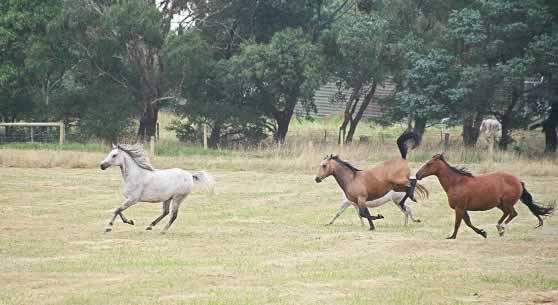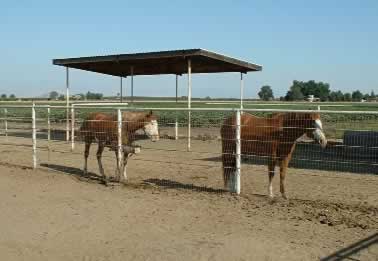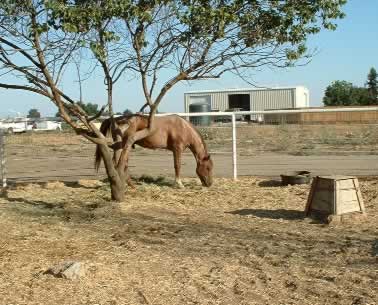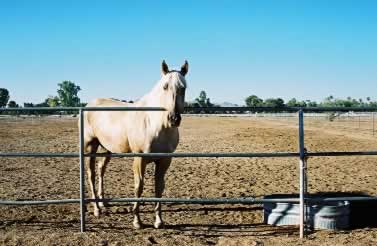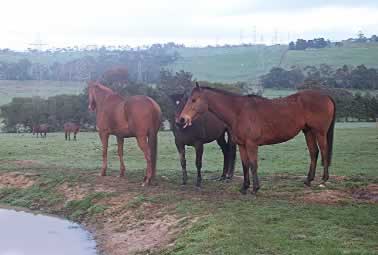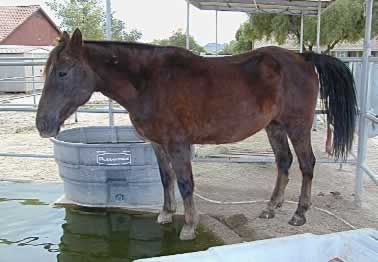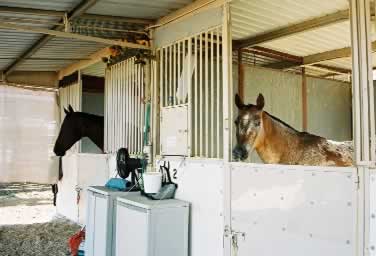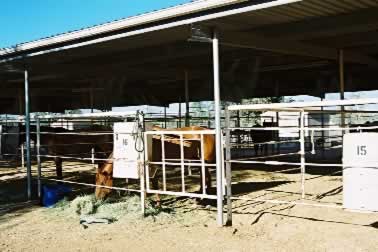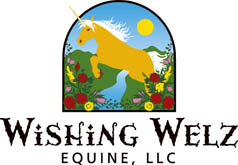What is Natural Boarding?
by Yvonne Welz ©2007
From Issue 16, Summer 2004 of The Horse's Hoof Magazine
It's easy to get confused about what Natural Boarding means. After all, in nature, horses roam hundreds, if not thousands, of acres of land. What can be natural about keeping them in any kind of captivity, behind any kind of fencing? Many people think Natural Boarding is impossible unless you have 40 acres or more, or that it can't work for horses living in small paddocks in cities and suburbs. But that's not what this is about--although 40+ acres may be an ideal, everyone can make things better and more natural for their horses in their own unique situation.
We can refer to Dr. Strasser's A Lifetime of Soundness for details on the problems with conventional boarding, and solutions to create Natural Boarding conditions. There are no absolutes, thus it is important to understand why things are harmful, in order to make the necessary adjustments to improve living conditions. We will examine all these 11 elements below:
1. Environmental temperature
In Nature, temperature fluctuates constantly, and the horse's body learns to adapt to these changes. The horse's own thermoregulatory system is fantastic, and does not need our interference.
In Conventional Boarding, we interfere with layers of blankets and sheets, usually color-coordinated and spiffy looking, but certainly not an improvement upon nature. In Natural Boarding, we leave the horse to experience the constantly changing natural climate, living outdoors with no horse clothing needed.
"To the proper stimulation of the thermoregulatory system, it is irrelevant on how many acres the horse experiences its natural climate; important is only that is is exposed to it."--A Lifetime of Soundness
2. Movement
In Nature, the horse is unrestricted and in virtually continual motion. In Conventional Boarding, the horse is usually very restricted, often receiving inadequate movement, as well as unnatural movement during its brief exercise periods. In Natural Boarding, the horse is allowed constant natural movement with paddock or pasture access 24/7. The more restricted the living space (such as a tiny paddock or pen), the greater will be the owner's responsibility for providing the correct amount of daily movement (equivalent to 10-15 miles per day) through riding, driving, or ponying.
3. Lifestyle
In Nature, horses live in the complex social system of the herd. In Conventional Boarding, some horses are forced to live in virtual solitary confinement, locked in box stalls with no access to other horses. In Natural Boarding, we provide horses with the company of other horses, to live in a herd if at all possible, but at least to have constant physical access to other horses.
4. Nutrition
In Nature, there is a huge variety of nutritional options with hundreds (or thousands) of plant species, and continuous uptake of food. In Conventional Boarding, we often restrict not only intake, but also variety. The horse may be limited to the consumption of only a couple of plant species, denied access to minerals that it craves, and be fed "meals" two to three times daily and left without food overnight--all of which are totally foreign to its natural eating patterns. In Natural Boarding, we try to provide continuous food uptake via free choice hay and/or pasture, and as much nutritional variety as we can manage. Free choice minerals are also available to the horse.
5. Body posture
In Nature, the horse spends most of the day in the grazing position, therefore head-low, with the center of gravity forward and the forehand bearing most of the weight. In Conventional Boarding, horses are often fed from elevated feeders, in an unnatural position that causes stress on the tendons and ligaments, as well as respiratory problems. In addition, any horses kept in an enclosed stall will constantly be in a head high posture, in an attempt to see outside the stall. In Natural Boarding, we feed our horses at ground level, as well as ride in as natural a posture as possible, with a relaxed neck.
6. Body weight
In Nature, body weight changes gradually through the seasons, with weight gain in summer, and weight loss in winter. Pregnant mares also gain weight slowly, although the birth of the foal does cause a sudden weight change! In Conventional Boarding, the weight changes suddenly with the addition of the rider--which may cause adverse effects in a horse stressed by unnatural living conditions. In Natural Boarding, we try to make the horse as healthy as possible to withstand this sudden, unnatural increase in weight.
This is the ultimate in Natural Boarding. This is the ideal--but is this reality for most horses? Unfortunately, not. While more space is always better, Natural Boarding is about taking what you've got, and improving it. These lucky horses live in Australia.
Photo courtesy Steve Golding
The photo right illustrates common living conditions in the Southwestern U.S. This situation fulfills the requirements of natural boarding, if the owner provides nutritional variety (not present in this example, because of lack of space and no vegetation), hoof soaking, and exercise. These horses live in California.
Another California horse, and this one's a stallion. The problem with his living conditions is that he needs companionship--perhaps a gelding to live with him, if not a herd of mares all his own. We will assume that the owner is providing nutritional variety, hoof soaking, and exercise.
7. Exposure of hooves to water
In Nature, horses' hooves are exposed daily to the water that they drink from. It can't be any other way--they must wade into a pool, river, or creek in order to drink. In Conventional Boarding, horses' hooves are usually not exposed to water daily, especially not immersed like in a drinking pool. In Natural Boarding, we provide daily exposure of hooves to water, immersing the hoof in a boot, bucket or hoof bath over the coronet band for 10-15 minutes daily.
"It is not water that is harmful to the health of the hooves, but the lack of it."--A Lifetime of Soundness
8. Resting places
In Nature, horses rest in open spaces, for only short periods of time during the day and night. In Conventional Boarding, we often force the horse into an enclosed space, a cozy "cave" that is the opposite of what the horse needs to feel safe. Since horses do not have our day/night rhythm, a horse stalled overnight will face endless hours of boredom. In addition, stalled horses suffer greatly from the effects of ammonia, which damages both their lungs and their hooves. In Natural Boarding, we provide the horse with, at most, an open shelter for protection against weather, although trees will suffice.
The horses probably won't sleep in the shelter, though!
9. Presence of grease or oil on hooves
In Nature, horses do not seek out oil sources to coat their hooves with, therefore they have no need for grease coatings on their hooves. In Conventional Boarding, hooves are often painted with all sorts of topicals, often in a vain attempt to strengthen, improve, or even moisturize the hoof. In Natural Boarding, we rely on the moisture of daily soaking--though in very dry climates the application of natural hoof dressings to seal in that soaking moisture may be useful.
10. Immediate and direct ground contact of hooves
In Nature, the horses have direct contact with the ground throughout their entire lives. In Conventional Boarding, hooves are often shod, which prevent this ground contact. In Natural Boarding, we return the horse to its natural barefoot state.
11. Clothing and protective wear
In Nature, these things simply do not exist. In Conventional Boarding, leg wraps, bandages, blankets, fly sheets, etc. are commonly used, again usually color coordinated and quite pretty.
In Natural Boarding, we look seriously at the benefits of such items of clothing, and find that they really don't do much, if anything, for the horse--therefore we can let the horse be bare all over.
Natural Boarding is about trying to make the best choices you can in your situation. The horse should be living outdoors, in as large an area as possible, in the company of other horses, and free from horse clothing. He should be receiving the proper amount of daily exercise, allowed free choice access to hay or pasture, and provided with free choice minerals and nutritional variety. His barefoot hooves should be exposed to water over the coronary band daily.
This Arizona horse has plenty of space, so she may get quite a bit of exercise romping with the other horses (out of view) in this dry lot "pasture." The lack of vegetation or natural water source means that the owner will have to take care of those requirements.
Left: This photo (Photo courtesy Lezley Golding) from Australia shows the ideal situation of a natural water source for hoof bathing. However, the Arizona horse in the right photo (Photo courtesy Carol Peat) seems quite delighted with her manmade hoof pond! Owners who do not have access to bodies of water (natural or manmade) will need to resort to boots and buckets to fulfill the daily water requirement of Natural Boarding.
I hear all the time, "we don't bother to soak any more," especially from owners in dry climates. This is a huge mistake, as hooves will contract from lack of moisture and develop white line problems. If you are having trouble with soaking causing seemingly negative effects, you need to experiment to see what you can do to make it work. Natural hoof dressings to seal moisture in extremely arid conditions, and water additives to change the pH of the water are just a couple ideas for people having the soaking blues.
Now on to some harder situations. (Left) We all know that box stalls are "bad." However, (Right) what if that box stall is attached to a run? Now the horses have room to move, the company of others, and notice the free-choice grass hay spread out. If the owner provides the necessary amount of daily exercise, plus hoof soaking and nutritional variety, this can still constitute natural boarding. Ideally, the attached runs should be much larger.
Another common Southwest scenario: the "mare motel." A far cry from box stalls, these often quite large covered pens provide access to horses on all sides, fresh air, and an area to move around (albeit, still too small). Unfortunately, these pens are often bedded with shavings--but if the shavings are removed, and the owner is willing to provide exercise, nutrition and soaking, this can still be Natural Boarding. Any confined area will take extra time on the owner's part to make it work.
Evaluating Natural Boarding Conditions
A very simplified Natural Boarding checklist:1) Room to move around 24/7, in company of other horses.
2) No horse clothing.
3) Nutritional variety fed at ground height.
4) Barefoot hooves soaked daily in water.
5) Natural amount of movement daily (10-15 miles), through exercise if necessary.From Issue 16, Summer 2004 of The Horse's Hoof Magazine
©2007 by The Horse's Hoof. All rights reserved. No part of these publications may be reproduced by any means whatsoever without the written permission of the publisher and/or authors. The information contained within these articles is intended for educational purposes only, and not for diagnosing or medicinally prescribing in any way. Readers are cautioned to seek expert advice from a qualified health professional before pursuing any form of treatment on their animals. Opinions expressed herein are those of the authors and do not necessarily reflect those of the publisher.
